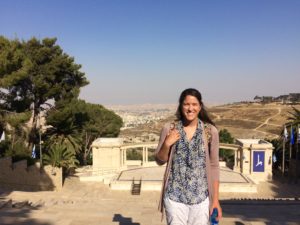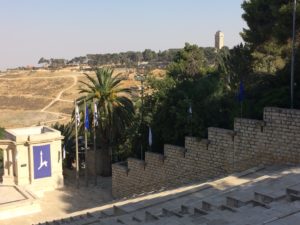

Ahlan wa Sahlan and Shalom! Here are two of the many ways to say ‘hello’ in Israel and the Palestinian territories. The first is Arabic–a language I have been trying to master for a few years now; the latter is modern Hebrew–a language which I am starting to learn this week in a summer ‘ulpan’ course at Hebrew University in Jerusalem. Both languages are important in this beautifully diverse yet conflict-ridden country and territories. Every street sign name is written in both languages (and sometimes English). The two languages parallel the two dominant cultural strains, Arab and Jewish, which are as intricately intermixed throughout this small region (the size of New Jersey) as the diversity of landscapes here–from deserts and Mediterranean beach fronts to swamp lands and arid mountain sides sprinkled with olive trees.
While the diverse peoples of this region can cross paths on an almost daily basis, I am quickly acclimating to the reality of a plethora of delicate and muted, almost invisible, divisions that exist around me. The average American tourist, like myself on my first visit here a few years ago, might miss these subtleties.
For instance, my campus is on Mount Scopus but I am living on the next hill over. The first is a Jewish area while the second is Arab. On a shopping trip, when I tried to take a Jewish cab from the first area to the second, the driver, in his Hebrew-lettered cab, refused to take me. He promised that this was not because he has something against Arabs–he shared that he has many Muslim and Christian Arab friends–but because it was not safe for him. It is just not done. Instead, he was willing to take me to the edge of the Arab neighborhood (on the edge of my university campus) and I had to walk the rest of the way.
Again, I wanted to buy a bus pass for the summer. However, the buses which run from my campus to the main center of Jerusalem are Hebrew-lettered while the buses which run from my neighborhood where I live to the main center are Arabic-lettered: two totally different bus lines running to the same place. This means that I will have to buy two bus passes, written in two different languages, and remember to pull out the correct one depending on where I am and where I am going.
I greet the Christian Arab staff of the guesthouse I live in every morning saying “Sabeh el-kheir” and I do the same to the university worker from whom I buy my morning coffee (instant but it’s growing on me) with “Boker Tov”. Of course, many in and around Jerusalem know both languages (or only one and English or some combination of both with a little English, etc.). Yet there are subtle signs of when one language will be more appropriate than the other. As an American, I have the ability to travel–relatively freely–from one area of the city to another, and to switch from one language into another. These delicate divisions demonstrate to me, even early in my time here, the importance of learning both languages and immersing myself in the many different cultures (there are, of course, many more than two) and trying to understand those who call this place home–whether in Arabic or Hebrew–in the language which best expresses their native perspectives.